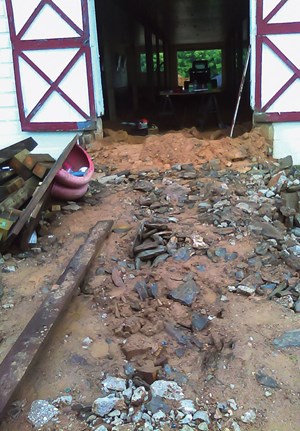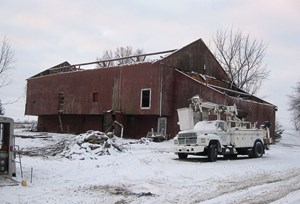
When American novelist Ellen Glasgow said, “All change is not growth, as all movement is not forward,” she might as well have been talking about barn renovating. The truth is, building and updating your property are not for the faint of heart—especially when you realize that the project is never-ending. What can be learned from this process is that not everything needs to be replaced. Working with what you have not only will save you time and money but will make your equine property one-of-a-kind and cut down on the environmental impact of leveling structures and starting from scratch.

I know this because I am two years into my own farm renovation in Maryland. It began with gutting our dairy barn. The inside now features updated electrical, automatic waterers, brand-new horse stalls and hot water. However, the outside still looks like cows could live there. I spoke with other experienced barn renovators and we compiled a list of things to know before you start using your older farm structures for horsekeeping. Those experts include Kentucky farm owner Brianna Rogers, who replaced most of her vintage barn’s exterior, and Justin Smith, the historic consultant at Timeless Barn Company in Frankfort, Indiana, who salvages barn timbers for reuse in new buildings.
Assess What You Have

Vintage barns were designed to shelter animals and can be a great option for horsekeeping, says Smith. “Generations of craftsmen and farmers have left buildings that are perfect in design and function. And while new buildings can be cheaper and just as effective, they do not have the character of old barns.” If you have an existing outbuilding on your property, start by working with professionals to assess what is salvageable. Knowing what must be replaced will allow you to begin calculating the costs and time associated with a possible renovation.
Smith emphasizes that some barns are too far gone to be used for anything. “What often kills a historic structure is neglect,” he says. “When holes develop in the roof, water infiltrates the barn and creates moisture issues that attract pests, mold and wood-boring insects.”
Make sure that your reclaimed lumber doesn’t have an active infestation of pests like termites, death watch or powderpost beetles, advises Smith. If that is the case, an experienced professional should be approached to make sure the lumber is stable for interior use.
My husband, Mike, an architectural engineer, made sure that we had a pre-purchase barn inspection. We confirmed that the building was structurally sound and all we needed to replace were the support columns, electrical wiring and horse stalls. Knowing this was one of the reasons we went ahead with the farm purchase. Without Mike’s advice and knowledge, I could have been stuck with a brand-new farm that required an unplanned, expensive and time-consuming demolition. Instead we were able to go ahead with our predicted renovations as planned.

Renovate When You Must
Rogers learned just how important structural soundness is to safety. She had been keeping horses in her century-old barn for the past 23 years when a tornado came through January 30. The building sustained foundation damage and lost an outside stall but remained standing.
The disaster gave Rogers a chance to repair and update the building’s exterior, as she had done to the interior a few years ago, so it would be even stronger and more horse-friendly. “The foundation and some of the blocks had to be redone,” says Rogers. “We raised the pitch a foot on one of the eaves, to make it taller where I have horses stabled. The rafters were replaced with two-by-eights for added strength. At the same time, all of the two-by-fours were replaced on both eaves. The metal on the building’s exterior was completely redone, insulation was
added to the eaves and the barn got new exterior paint.”
While Rogers focused on her barn’s the exterior in her most recent renovation, our own building needed most of the repair on the inside. At one time, the support columns had been replaced with salvaged telephone poles, and half of the ceiling was sagging as a result. The concrete aisle had to be demolished to reset the columns, so we made the decision to also dig the floor down almost three feet so the ceiling height would be more horse-friendly. When we were done, the building was much safer for horses and we were able to put in stalls that were 12-by-12 with a 12-foot clearance above. It is worth noting that not all vintage barns are as wide as many new facilities so if you want horse stalls that are 10 or 12 feet deep, you should make sure to check what aisle width that leaves you. It would be a shame to get halfway through only to realize you have a prohibitively narrow center aisle.

Salvage What You Can
Whether you own a vintage building that cannot be saved or are building a new barn, consider the salvaged-wood option. While our dairy barn was structurally sound, the bank barn on our property would have cost more than $150,000 to keep standing. When all was said and done, the foundation, siding and roof would have had to be replaced. Instead, we opted to have someone salvage the wood frame.
“Reclaimed materials are a popular alternative for someone who is looking for an aesthetic option that is different from what one finds at a home improvement store,” says Smith. “The unique texture, appearance and historical significance make each piece of reclaimed lumber or stone unique. That cannot be replicated.”
Smith points out that reclaimed barn wood can be used in homes, offices or stables. “Whether you are staining or oiling the wood to keep the natural patina or sawing it to produce smooth surfaces that compliment a modern design style, barn wood is surprisingly versatile,” he comments.

After posting on thebarnpages.com, a website that allows you to sell vintage barns, a New York family purchased our timber-frame bank barn for a few thousand dollars and took care of disassembly and removal. When all was done, we just had a foundation to cover with dirt.
Now that the renovations have settled down at our farm as well as at Brianna Roger’s place, we can sit and admire that not everything needs to be replaced. The ceiling is still not completely level and there are always going to be chips in the exterior paint layers. However, like any renovating veteran or vintage barn owner, I now have a better idea of when it is best to leave well enough alone. Glasgow was right when she said that we don’t always have to change things. That is why I am going to enjoy what we have and just sit back and admire it for a while.












